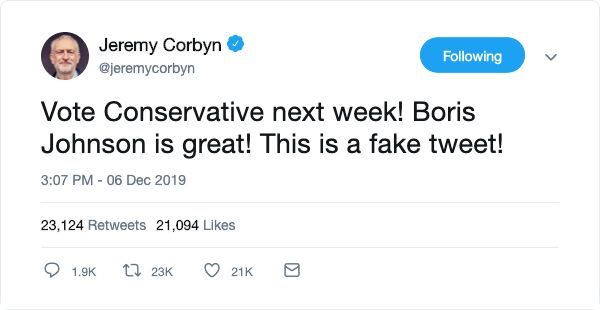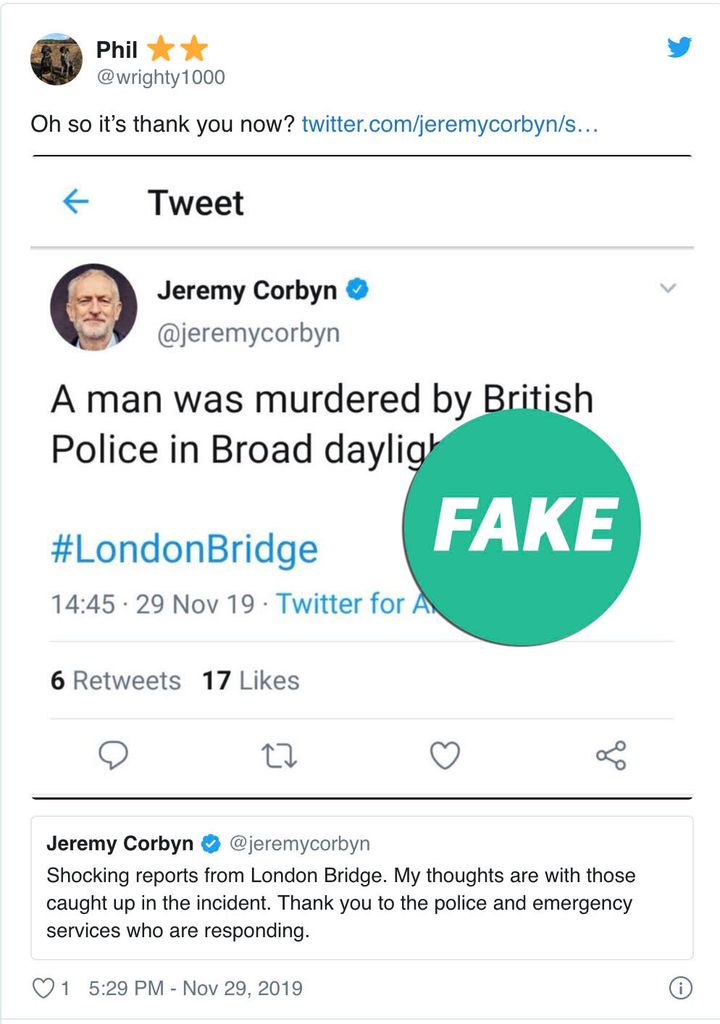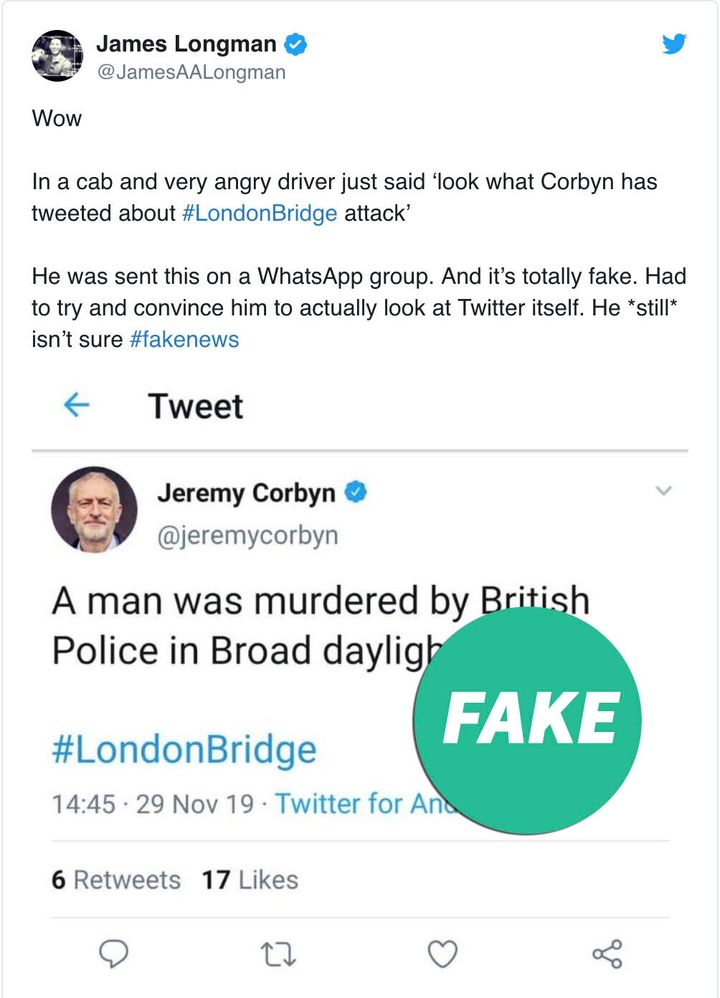In the immediate aftermath of the London Bridge terror attack, Jeremy Corbyn tweeted his condolences, thanked the emergency services and said his “thoughts are with those caught up in the incident”.
But there was one problem – someone had beaten him to it with a fake tweet claiming he had condemned police for “murdering” the attacker who killed two people and injured three others.
Before the death of Usman Khan had been confirmed, the imposter post had spread over social media sites like Twitter, WhatsApp and 4Chan.
Alastair Reid, digital editor at First Draft, told HuffPost UK the fake was both crude and devastatingly sophisticated at the same time, taking seconds to create but proving near-impossible to counteract as its content was crafted to play into existing established narratives.
“Jeremy Corbyn’s views on things like security, armed police, shoot-to-kill have been repeatedly misrepresented and used as a stick to beat him and Labour with,” he added.
“It is scarily easy to fake screenshots, whether that’s of tweets or websites or Facebook posts or whatever.”
How easy? HuffPost UK made this one with a readily-available online tool in around 20 seconds.

Here’s how quickly the fake tweet appeared and spread.
Friday, November 29
1.55pm
Armed with a knife, Usman Khan inflicts fatal wounds on 23-year-old Saskia Jones and 25-year-old Jack Merritt and injures three others.
1.58pm (+ 3 mins)
The Met Police receive the first call alerting them to the ongoing attack at Fishmongers’ Hall near London Bridge.
2.03pm (+ 8 mins)
Khan is shot dead by police after being chased out of Fishmongers’ Hall and tackled to the ground by a group of men on London Bridge, one armed with a 5ft narwhal tusk.
Another, 24-year-old Thomas Gray, later said: “I was brought up on rugby and the rule is ‘one in, all in’. I did what any Londoner would do and tried to put a stop to it.”
2.11pm (+ 16 mins)
Sixteen minutes after the attack began, the first tweets from the public mentioning an incident on London Bridge are posted. The details are sketchy and there is confusion about what the attacker is armed with and who exactly is doing the shooting
2.13pm (+ 18 mins)
Two minutes later, the first tweet specifically claiming the police had shot someone is posted.
At the same time, the Met Police confirm they are dealing with an “incident” though no further details are given.
2.17pm (+ 22 mins)
About 22 minutes after the attack began, the media starts sending out alerts on the developing story.
2.21pm (+ 26 mins)
The first video, taken by a passenger on a bus that was crossing London Bridge, is posted to Twitter.
It depicts heavily-armed police pointing their weapons at the attacker. He is not moving but it has not yet been confirmed he is dead.
2.34pm (+ 39 mins)
By this time a number of videos of the incident are circulating on Twitter, clearly showing the attacker being shot.
2.46pm (+ 51 mins)
The first example of the fake Jeremy Corbyn tweet posted to Twitter comes from an account called “JeSuisCanard” at 2.46pm – just 51 minutes after the attack began and before even police confirm anyone has been shot.
Note: We’ve added the ‘fake’ badge ourselves. Obviously, it wasn’t included in the original hoax.

“We saw it in some pro-Brexit and anti-Labour Facebook groups and pages and eventually traced it back to a handful of Twitter users who were actively seeking out viral footage of the incident on the bridge and posting the tweet in the replies,” Reid says.
“They were actively trying to get it seen by as many people as possible and then laughing about it.”
3.22pm (+ 87 mins)
Nearly one and a half hours after the attack began, and 36 minutes after the fake tweet was posted, the police confirm for the first time that a shooting has taken place.
3.39pm (+ 104 mins)
Jeremy Corbyn’s official account tweets the Labour leader’s genuine message of sympathy and condolences.
4.24pm (+ 149 mins)
In a press conference, Neil Basu, the head of UK counter-terrorism policing, confirms the person shot dead on London Bridge was the attacker.
5.29pm (+ 214 mins)
Despite Corbyn’s real tweet being posted over two hours ago, the fake version has been picked up by a number of people on Twitter who think it is real.
One person even replies to the genuine tweet with the fake version, saying: “Oh, so it’s thank you now?”

“For people who had been on the receiving end of this narrative for a long time, the tweet appeared to fit their view of Corbyn,” Reid says.
“This is a key part of how disinformation works: the idea of confirmation bias. We, as human beings, are more biased to believe something if it confirms our existing views.
“It’s just easier that way and it takes less brain power to process something that doesn’t contradict our core beliefs or existing ideas.”
5.49pm (+ 234 mins)
At 5.49pm, ABC News journalist James Longman says he has been shown the fake tweet by a cab driver who had been sent it on WhatsApp.

Worryingly, Longman adds that even though he told him to look at Corbyn’s real tweet, he is still not convinced the fake tweet is actually fake.
“For people who had been drip-fed the idea of Corbyn as a terrorist sympathiser, this was like a laser-guided missile. It went straight through their defences, their critical thinking, and hit an emotional core,” Reid says.
The exact impact of the fake tweet is nearly impossible to determine, but based on social media posts and anecdotal evidence, it was seen and believed by members of the public – a worrying prospect just days away from a general election.
Ultimately, it is up to the public to check information, particularly that which comes from social media.
“Disinformation is designed to trigger an emotional response and tap into people’s core beliefs. So if you see something online that makes you angry or makes you laugh, that is a sign that it might not be true,” Reid says.
“Does the source have a clear link to a party or campaign group? Is it always attacking one side of a debate and promoting another?
“Then, can you find evidence of the claim elsewhere? Has anyone else reported it and are they reliable sources?”
A toolkit for identifying misleading information online is available from Full Fact here.
